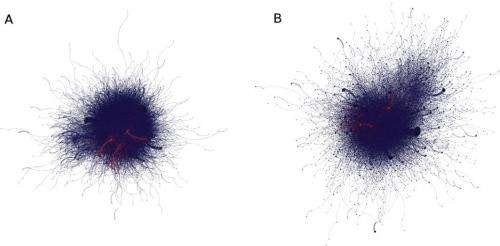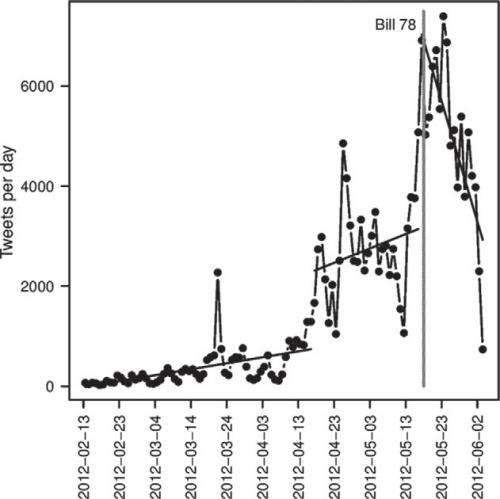January 20, 2014 feature
Anti-protest law changes Twitter users' behavior, but not network structure, physicists show

(Phys.org) —With the rise of social media, it is possible to organize public demonstrations on larger scales and in less time than ever before. In response, some governments are trying to decide how to regulate and impede the organization of these demonstrations, in order to maintain safety, order, or for other reasons. But very little is known about exactly how repressive legislation affects social media networks and their users. New research now suggests that social networks may be surprisingly resistant to such legislation.
In a new paper published in EPL, Marianne Marcoux and David Lusseau at the University of Aberdeen in Aberdeen, UK, have analyzed millions of tweets from Twitter users in Quebec, Canada, who were protesting an increase in college tuition in 2012. That winter, 300,000 students—about 75% of all college and university students in Quebec—went on strike for several weeks. The strike and related protests were organized primarily with Twitter.
On May 18, after 14 weeks of the strike, the Quebec government passed special emergency legislation called Bill 78 in an attempt to block the organization of the protests. Bill 78 requires that any organizer of a demonstration involving more than 50 people must provide the local police with an itinerary of the demonstration at least 8 hours before the event, and also ensure that the demonstration follows the itinerary. Individuals and organizations that did not follow Bill 78 were severely fined, and the government also considered fining any individual who transferred information about illegal demonstrations.
To determine what effect Bill 78 had on Twitter users, the researchers compared the behavior of Twitter users who were involved in the protests, as well as the structure of their interaction network, before and after the passage of the bill. They analyzed nearly 200,000 tweets sent from February 12 to June 4, 2012, that contained relevant hashtags, using Twitter data that was made freely available by O. H. Beauchesne at olihb.com.
The researchers' main result was that the legislation changed the behavior of Twitter users, but not the overall structure of the network in which they interacted. In terms of behavior, although the number of tweets posted per day was higher on average after Bill 78 was implemented than before, the rate of increase dropped. Twitter users also showed an increase in "cliquishness" by limiting the tweets they sent to users within tight clusters to which they belonged. The researchers suspect that this change in behavior may indicate that the students became more cautious regarding who they sent tweets to.

On the other hand, the network structure was relatively the same before and after the legislation. The structure was hierarchical and followed a scale-free distribution, in which a few Twitter users had very high rates of tweet exchanges while most users had low rates of exchanges. The few individuals with high connectivity were positioned between cliques, while users with low connectivity tended to be part of highly connected cliques.
"Our work shows that social media are very powerful tools to spread information," Marcoux told Phys.org. "The reason for this is because of the scale-free and hierarchical structure of social media networks, in which some highly connected individuals act as hubs to transfer information. In such a network, it only takes a few steps for information to travel between two individuals at extreme locations on the network. Also, the overall structure of the network of interactions on Twitter did not change after the passage of the Bill. Thus, information could still travel quickly after the passage of the Bill. It demonstrates nicely the resilience of big scale-free and hierarchical networks to perturbations."
Because the network structure was not significantly affected by the legislation, information about the protests continued to flow through the network like before. Individuals were still able to organize mass protests, despite some changes in user behavior. Overall, the researchers concluded that this natural experiment shows the power of social media to connect and mobilize a large number of individuals, as well as the resilience of social networks to changes in individual behavior. As the researchers note, a better understanding of networks is already helping policymakers in other areas.
"Policymakers can use network knowledge to influence social changes," Marcoux said. "For example, in a vaccination campaign, a better understanding of the social structure of a community might help to identify key individuals (highly connected hubs) that could speed up the spread of positive information about vaccination."
Currently, the researchers are working on other projects, although they explain that more work could be done in this area.
"This project was a side to my other research projects, but I would love if someone took over to look at the content of messages that were sent before and after the legislation," Marcoux.
More information: Marianne Marcoux and David Lusseau. "The influence of repressive legislation on the structure of a social media network." EPL, 104 (2013) 58004. DOI: 10.1209/0295-5075/104/58004
Journal information: Europhysics Letters (EPL)
© 2014 Phys.org. All rights reserved.




















